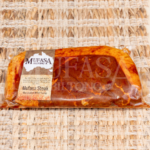
How to Make Biltong at Home
Biltong is a popular dried meat snack with South African origins. It is similar to beef jerky but has a distinct taste and texture due to its unique preparation method. Traditionally, it is made using beef, game, or even ostrich meat, flavored with vinegar and spices before air-drying. Making biltong at home is simple and allows you to control the flavors and texture to suit your preference.
Ingredients
To make a batch of this delicious dried meat, you will need the following ingredients:
1 kg of beef (sirloin, silverside, or rump)
2 tbsp coarse salt
1 tbsp black pepper (coarsely ground)
1 tbsp coriander seeds (lightly toasted and crushed)
1 tbsp brown sugar
½ cup vinegar (malt or apple cider)
1 tsp paprika (optional for added flavor)
1 tsp chili flakes (optional for heat)
Equipment
A sharp knife
A large mixing bowl
Paper towels
Butcher hooks or a drying rack
A biltong box or a well-ventilated drying area
Step-by-Step Instructions
1. Choose the Right Meat
Selecting the right cut is crucial to achieving the best results. Lean cuts such as silverside or rump work well because they have minimal fat, which can turn rancid during drying. Ensure the meat is fresh and free of excessive sinew.
2. Prepare the Meat
Trim off any thick fat layers, then cut the meat into strips about 2 cm thick and 15-20 cm long. Always slice along the grain to ensure a good texture when drying.
3. Season and Marinate
Place the meat strips in a large bowl and pour the vinegar over them. Let them soak for about 30 minutes to help tenderize the meat and give it its distinct tangy flavor. After marinating, remove the strips and pat them dry with paper towels.
In a separate bowl, mix the salt, crushed coriander seeds, black pepper, brown sugar, and any additional spices you prefer. Coat each strip generously with the spice mixture, ensuring all sides are covered. Arrange the seasoned strips in a container, layering them and pressing down to allow the spices to penetrate. Cover and refrigerate for 12-24 hours.
4. Drying the Meat
After marinating, remove the meat from the fridge and pat it dry again. Shake off excess seasoning to prevent an overly salty taste. If using a drying rack, lay the strips out evenly to allow proper air circulation. If using hooks, hang them in a cool, dry place with good ventilation.
A biltong box is an excellent option for drying. It is a ventilated wooden or plastic box fitted with a fan and small air holes to ensure steady airflow. If you do not have one, you can use a dry, well-ventilated room, such as a pantry or garage, as long as it is free from insects and moisture.
5. Drying Time
The drying process typically takes 3-7 days, depending on the thickness of the strips and the climate. Warmer, drier conditions speed up the process, while humid environments may take longer.
To check for readiness, feel the strips. They should be firm but still slightly pliable. Some prefer a softer texture, while others like it dry and hard. Once the desired texture is reached, the meat is ready to enjoy.
6. Storing and Serving
Once dried, store the meat in a paper bag or airtight container. Avoid plastic bags, as they can trap moisture and cause spoilage. If stored in a cool, dry place, it can last for several weeks. For longer storage, freezing is an option.
Biltong is best enjoyed as a high-protein snack, sliced thinly and eaten on its own. It also pairs well with cheese, crackers, or even as an addition to soups and stews for added flavor.
Tips for Success
Avoid fatty cuts: Too much fat can spoil quickly, affecting the final product.
Use good air circulation: Ensuring a steady airflow helps prevent mold growth.
Experiment with flavors: Adding garlic powder, Worcestershire sauce, or different spice blends can create unique variations.
Monitor humidity levels: High humidity can slow drying and encourage mold. A fan can help improve airflow if needed.
Conclusion
Making biltong at home is a rewarding process that allows for customization in flavor and texture. By following the right steps, using quality ingredients, and ensuring proper drying conditions, you can enjoy this delicious South African delicacy anytime. Whether as a snack or an ingredient in recipes, homemade biltong is a great way to enjoy flavorful dried meat without preservatives.







